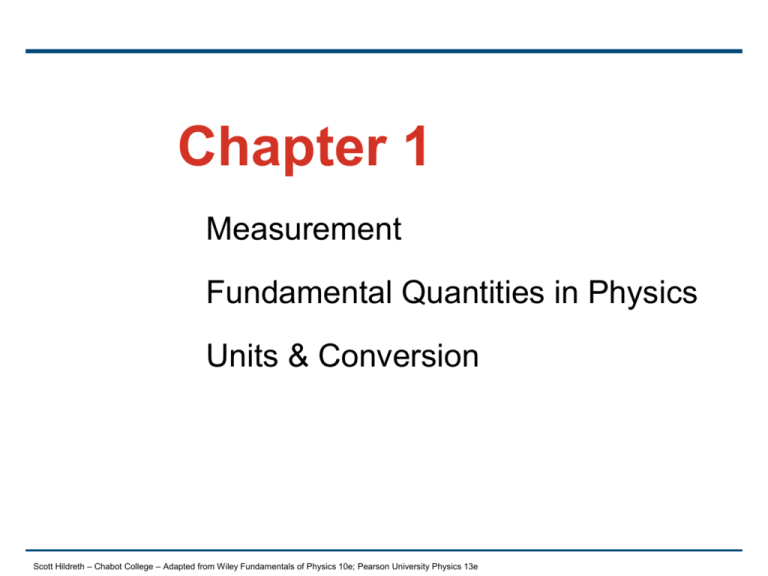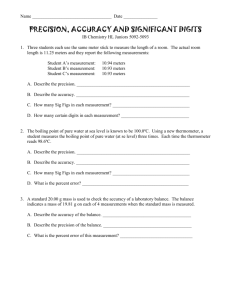Physics 4A Lecture 1
advertisement

Chapter 1 Measurement Fundamental Quantities in Physics Units & Conversion Scott Hildreth – Chabot College – Adapted from Wiley Fundamentals of Physics 10e; Pearson University Physics 13e Three KEYS for Chapter 1 • Fundamental quantities in physics (length, mass, time) – Units (meters, kilograms, seconds...) – Dimensional Analysis • Force = kg meter/sec2 • Power = Force x Velocity = kg m2/sec3 Three KEYS for Chapter 1 • Fundamental quantities in physics (length, mass, time) – Units (meters, kilograms, seconds...) – Dimensional Analysis • Significant figures in calculations – 6.696 x 104 miles/hour – 67,000 miles hour Three KEYS for Chapter 1 • Fundamental quantities in physics (length, mass, time) – Units (meters, kilograms, seconds...) – Dimensional Analysis • Significant figures in calculations • Estimation (order of magnitude ~10#) Standards and units • Length, mass, and time = three fundamental quantities (“dimensions”) of physics. • The SI (Système International) is the most widely used system of units. – Meeting ISO standards are mandatory for some industries. Why? • In SI units, length is measured in meters, mass in kilograms, and time in seconds. Converting Units •A conversion factor is •A ratio of units equal to 1 •Used to convert between units • Units obey same algebraic rules as variables & numbers Converting Units km Converting Units km 1000 m = 1 km Multiplying by 1 doesn’t change the overall value, just the units. Converting Units km Converting Units km Converting Units km cm Converting Units km cm Unit consistency and conversions • An equation must be dimensionally consistent. Terms to be added or equated must always have the same units. (Be sure you’re adding “apples to apples.”) • OK: 5 meters/sec x 10 hours =~ 2 x 102 km (distance/time) x (time) = distance Unit consistency and conversions • An equation must be dimensionally consistent. Terms to be added or equated must always have the same units. (Be sure you’re adding “apples to apples.”) • OK: 5 meters/sec x 10 hours =~ 2 x 102 km 5 meters/sec x 10 hour x (3600 sec/hour) = 180,000 meters = 180 km = ~ 2 x 102 km Unit consistency and conversions • An equation must be dimensionally consistent. Terms to be added or equated must always have the same units. (Be sure you’re adding “apples to apples.”) • OK: 5 meters/sec x 10 hours =~ 2 x 102 km • NOT: 5 meters/sec x 10 kg = 50 Joules (velocity) x (mass) = (energy) Unit prefixes • Larger & smaller units for fundamental quantities. • Learn these – and prefixes like Mega, Tera, Pico, etc.! • Skip Ahead to Slide 24 – Sig Fig Example Measurement & Uncertainty No measurement is exact; there is always some uncertainty due to limited instrument accuracy and difficulty reading results. Measurement & Uncertainty • The precision – and also uncertainty - of a measured quantity is indicated by its number of significant figures. –Ex: 8.7 centimeters • 2 sig figs • Specific rules for significant figures exist • In online homework, sig figs matter! • In exams, sig figs matter!! Significant Figures Number of significant figures = number of “reliably known digits” in a number. Often possible to tell # of significant figures by the way the number is written: • 23.21 cm = four significant figures. • 0.062 cm = two significant figures (initial zeroes don’t count). Significant Figures • Significant figures are not decimal places 0.00356 has 5 decimal places, but just 3 significant figures Generally, round to the least number of significant figures of the given data 25 x 18 → 2 significant figures; 25 x 18975 → still 2 Round up for 5+ (13.5 → 14, but 13.4 → 13) Significant Figures In general, trailing zeros are NOT significant In other words, 3000 may have 4 significant figures but usually 3000 will have only 1 significant figure! Numbers ending in zero are ambiguous. Does the last zero mean uncertainty to a factor of 10, or just 1? Significant Figures Numbers ending in zero are ambiguous Is 20 cm precise to 10 cm, or 1? We need rules! • 20 cm = one significant figure (trailing zeroes don’t count w/o decimal point) • 20. cm = two significant figures (trailing zeroes DO count w/ decimal point) • 20.0 cm = three significant figures Rules for Significant Figures •When multiplying or dividing numbers, or using functions, result has as many sig figs as term with fewest (the least precise). •ex: 11.3 cm x 6.8 cm = 77 cm. •When adding or subtracting, answer is no more precise than least precise number used. • ex: 1.213 + 2 = 3, not 3.213! Significant Figures •Calculators will not give right # of sig figs; usually give too many but sometimes give too few (especially if there are trailing zeroes after a decimal point). •top image: result of 2.0/3.0 •bottom image: result of 2.5 x 3.2 Scientific Notation •Scientific notation commonly used •Uses powers of 10 to write large & small numbers Scientific Notation •Scientific notation allows the number of significant figures to be clearly shown. •Ex: cannot easily tell how many significant figures in “36,900”. •Clearly and 3.69 x 104 3.690 x 104 has three has four! Remember trailing zeroes DO count with a decimal point (always in Scientific Notation!) Measurement & Uncertainty No measurement is exact; there is always some uncertainty due to limited instrument accuracy and difficulty reading results. Photo illustrates this – it would be difficult to measure the width of this board more accurately than ± 1 mm. Uncertainty and significant figures • Every measurement has uncertainty –Ex: 8.7 cm (2 sig figs) • “8” is (fairly) certain • 8.6? 8.8? • 8.71? 8.69? • Good practice – include uncertainty with every measurement! –8.7 0.1 meters Uncertainty and significant figures • Uncertainty should match measurement in the least precise digit: –8.7 0.1 centimeters –8.70 0.10 centimeters –8.709 0.034 centimeters –8 1 centimeters • Not… –8.7 +/- 0.034 cm Relative Uncertainty •Relative uncertainty: a percentage, the ratio of uncertainty to measured value, multiplied by 100. •ex. Measure a phone to be 8.8 ± 0.1 cm What is the relative uncertainty in this measurement? Uncertainty and significant figures • Physics involves approximations; these can affect the precision of a measurement. Uncertainty and significant figures • As this train mishap illustrates, even a small percent error can have spectacular results! Conceptual Example: Significant figures Using a protractor, you measure an angle to be 30°. (a) How many significant figures should you quote in this measurement? Conceptual Example: Significant figures Using a protractor, you measure an angle to be 30°. (a) How many significant figures should you quote in this measurement? What uncertainty? 2 sig figs! (30. +/- 1 degrees or 3.0 x 101 +/- 1 degrees) Conceptual Example: Significant figures Using a protractor, you measure an angle to be 30°. (b) What result would a calculator give for the cosine of this result? What should you report? Conceptual Example: Significant figures Using a protractor, you measure an angle to be 30°. (b) What result would a calculator give for the cosine of this result? What should you report? 0.866025403, but to two sig figs, 0.87! 1-3 Accuracy vs. Precision Accuracy is how close a measurement comes to the true value. ex. Acceleration of Earth’s gravity = 9.81 m/sec2 Your experiment produces 10 ± 1 m/sec2 • You were accurate! How accurate? Measured by ERROR. • |Actual – Measured|/Actual x 100% • | 9.81 – 10 | / 9.81 x 100% = 1.9% Error Accuracy vs. Precision •Accuracy is how close a measurement comes to the true value • established by % error •Precision is a measure of repeatability of the measurement using the same instrument. • established by uncertainty in a measurement • reflected by the # of significant figures Accuracy vs. Precision Example •Example: You measure the acceleration of Earth’s gravitational force in the lab, which is accepted to be 9.81 m/sec2 • Your experiment produces 8.334 m/sec2 •Were you accurate? Were you precise? Accuracy vs. Precision Accuracy is how close a measurement comes to the true value. (established by % error) ex. Your experiment produces 8.334 m/sec2 for the acceleration of gravity (9.81 m/sec2) Accuracy: (9.81 – 8.334)/9.81 x 100% = 15% error Is this good enough? Only you (or your boss/customer) know for sure! Accuracy vs. Precision Precision is the repeatability of the measurement using the same instrument. ex. Your experiment produces 8.334 m/sec2 for the acceleration of gravity (9.81 m/sec2) Precision indicated by 4 sig figs Seems (subjectively) very precise – and precisely wrong! Accuracy vs. Precision Better Technique: Include uncertainty Your experiment produces 8.334 m/sec2 +/- 0.077 m/sec2 Your relative uncertainty is .077/8.334 x 100% = ~1% But your error was ~ 15% NOT a good result! Accuracy vs. Precision Better Technique: Include uncertainty Your experiment produces 8.3 m/sec2 +/- 1.2 m/sec2 Your relative uncertainty is 1.2 / 8.3 x 100% = ~15% Your error was still ~ 15% Much more reasonable a result! Accuracy vs. Precision •Precision is a measure of repeatability of the measurement using the same instrument. • established by uncertainty in a measurement • reflected by the # of significant figures • improved by repeated measurements! •Statistically, if each measurement is independent • make n measurements (and n> 10) •Improve precision by √(n-1) • Make 10 measurements, % uncertainty ~ 1/3 1-6 Order of Magnitude: Rapid Estimating Quick way to estimate calculated quantity: • round off all numbers in a calculation to one significant figure and then calculate. • result should be right order of magnitude • expressed by rounding off to nearest power of 10 • 104 meters • 108 light years Order of Magnitude: Rapid Estimating Example: Volume of a lake Estimate how much water there is in a particular lake, which is roughly circular, about 1 km across, and you guess it has an average depth of about 10 m. Order of Magnitude: Rapid Estimating Example: Volume of a lake Volume = Area x depth = (p x r2) x depth = ~ 3 x 500 x 500 x 10 = ~75 x 105 = ~ 100 x 105 = ~ 107 cubic meters Order of Magnitude: Rapid Estimating Example: Volume of a lake Volume = (p x r2) x depth = 7,853,981.634 cu. m But…. Round to power of 10 for Order of Mag: So ~ 107 cubic meters 1-6 Order of Magnitude: Rapid Estimating Example: Thickness of a page. Estimate the thickness of a page of your textbook. (Hint: you don’t need one of these!) Solving problems in physics • The online system offers a HUGE array of additional resources to help you visualize how to solve problems Solving problems in physics • The online system offers a HUGE array of additional resources to help you visualize how to solve problems Solving problems in physics • The textbook sample problems are IMPORTANT Solving problems in physics – Step by Step! • Step 1: Identify KEY IDEAS, relevant concepts, variables, what is known, what is needed, what is missing. Solving problems in physics • Step 2: Set up the Problem – MAKE a SKETCH, label it, act it out, model it, decide what equations might apply. What units should the answer have? What value? Solving problems in physics • Step 3: Execute the Solution, and EVALUATE your answer! Are the units right? Is it the right order of magnitude? Does it make SENSE? Solving problems in physics • Good problems to gauge your learning – “Test your Understanding” Questions throughout the book – Conceptual “Clicker” questions linked online – “Two dot” problems in the chapter • Good problems to review before exams – Checkpoints along the way – ODD problems with answers in the back – Exam reviews published online









